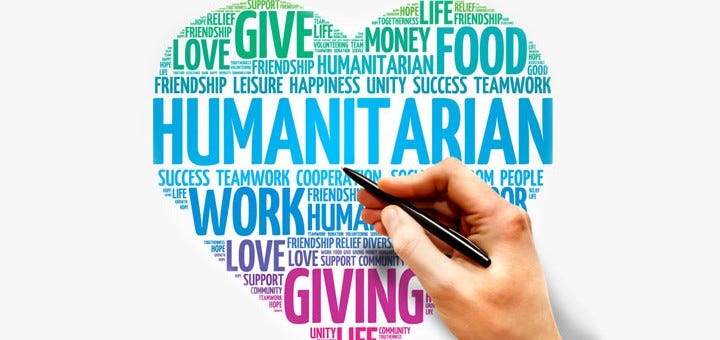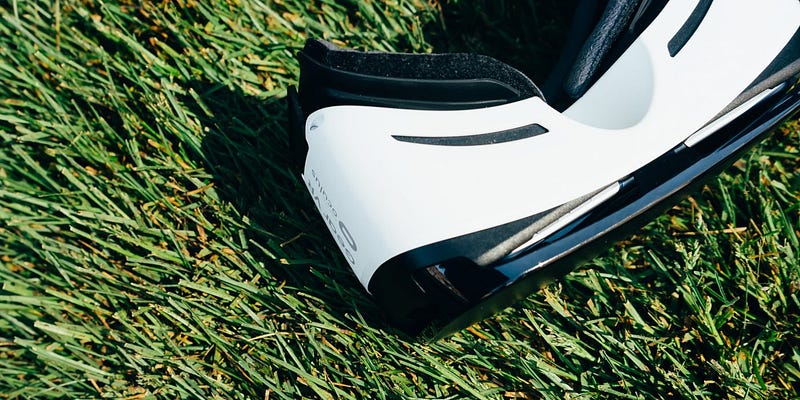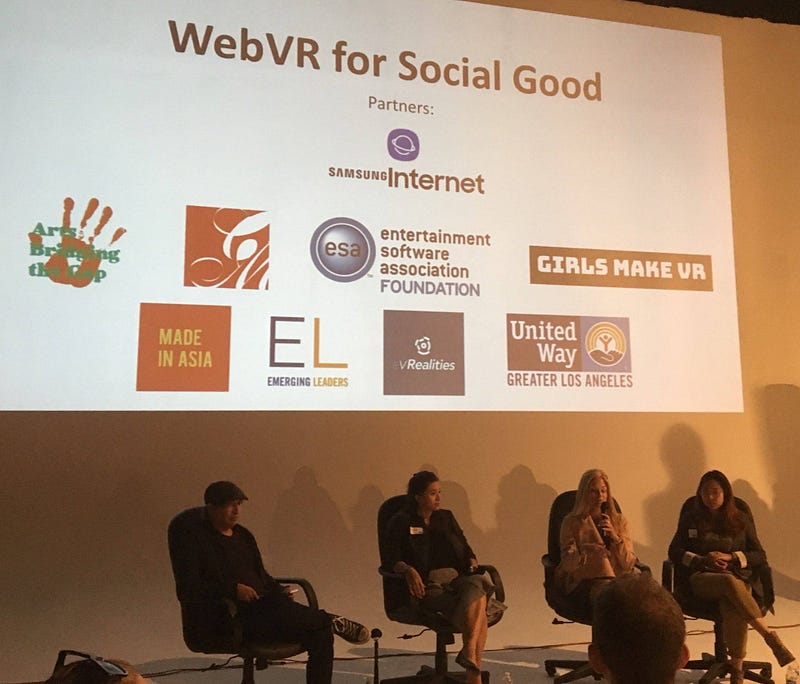WebXR for Social Good

Photo: © dizain
Lately I have seen an increase in the use of immersive technologies, especially virtual reality, for causes around social good. Social good is a term that implies a positive impact, on an individual or a society as a whole. Potable water, education, and healthcare are all examples of social good. However, new media innovations and the growth of online communities have extended the meaning of the term. Social good is now about global citizens uniting to unlock the potential of individuals, technology and collaboration to create positive societal impact.
Given my interest in immersive web technologies, I asked myself, “What is WebXR for social good”? Sure I can take the definition above and say it is about creating a positive societal impact using web based virtual and augmented reality, but I really wanted to explore this more and discover if anyone is using WebXR tech for social good and if so, how.

I started my journey and soon met content creators and others that were using these experimental technologies to create a positive societal impact. Knowing these stories of inspiration were too good to not share, we (Samsung Internet team) decided to start an event series that would highlight these folks’ work and provide insight for others that are interested in WebXR technologies for social good.
With the help of Georgia Van Cuylenburg, a social good focused content creator, the WebXR for Social Good event series came together. The first event of the series was a Q&A panel I moderated held this past January in Los Angeles and featured Georgia, Erika Barraza, and Jennifer Katanyoutanant.

Here are the questions and answers from the event.
- Tell us a little about yourself and what you are currently working on in the Immersive Web space.
GVC: Ensuring a better future for all humans — especially little ones — is the why of everything I do every day. I am so fortunate to have experienced the magic that exists in people that don’t even know it’s there themselves until they are given an opportunity to discover it or simply have someone that believes in them. Everything I do in immersive tech revolves around those moments and the moments of profound connection we are able to create. I am one of the founders of Girls Make VR — we teach under-served girls to create immersive content that goes beyond entertainment. I also work as an immersive documentary film maker and get to work in a number of different fields — medical, wellness and education helping people apply VR to their people focused challenges.
EB: I am the founder and CEO of EVRealities, the secure marketplace for News and Digital Publishers to source VR/AR content. I have worked in immersive media and the democratization of technology since 2013. EVRealities is promoting the use of WebXR combined with Blockchain encryption for immersive Journalism content publishing, licensing, and rights management.
JK: I’m the Founder of Made in Asia, a communications and new media consultancy, and Director of the Made In Asia Creative Tech Lab at cultural and civic hub, Bangkok 1899. I produce tech and art initiatives and lead community driven immersive media projects, such as a collaborative painting program for kids and artists. My main goal is to provide accessibility to immersive media for Southeast Asian creative communities.
2. What does social good mean to you?
GVC: It means creating change — in people, in circumstance in wicked challenges and creating a better world (or the incredible world I believe is truly possible) for all humans. Change can come in the form of laughter, learning, understanding, actions and problem solving. If there is joy, ability, solutions and peace where there once wasn’t — that is social good.
EB: Social Good is a behavior built into every business decision. It is something we consider as we design for reach, scale, and access; the more people and industries that can become empowered from access and ease of implementation of our product, the better off we all are. For EVRealities specifically, we are focused on not just building something new, but building something right. This means technological empowerment and income potential for creators submitting their content to the marketplace. Decentralized content and democratized access to software tools for digital media publishers provides businesses of all sizes an opportunity to experiment and proactively build a communication strategy with VR and AR. Budgets of all size have an opportunity to build compelling and engaging content.
JK: In theory, my personal definition of social good means providing equitable access to resources. In practice, my definition of social good changes to fit my collaborators (the students and artists who partake in my programs). Above all else, social good starts with asking those around me what they want for themselves. I want people who have a goal to get whatever they need to make that goal happen.
3. What inspired you to go this route?
GVC: When I first witnessed the transformative effect that a simple VR experience had on people’s whole presence, I was hooked. I would see one person put on the headset and a totally new one take it off. That look of wonder showed me all I needed to know. We have spent years trying to create that in people with conversation with movies and with books but in 5 minutes it is done. That to me is endless possibility!
EB: I received my Masters in Business for Social Entrepreneurship in 2014. I set out to leverage my Theater and English degree with an analytical understanding of how to provide people with the resources they need to thrive. I turned away from the idea of pursuing a Law or Public Policy degree when I learned more about Patagonia and read Yvonne Chouinard’s book, “Let My People Go Surfing”. His method of actualizing the people working on staff and his understanding that a good business is built with whole and happy humans inspires me to look at people, environment, and product holistically.
JK: Innovation isn’t restricted to one country, one class, or one race. Everyone has the potential to create paradigm shifting piece of work, and I want to make sure that piece of work is made and seen. I’m inspired by all the artists, students, and technologists I’ve met around Southeast Asia, and I hope to make sure the world gets to see their work too.
4. Why immersive technology?
GVC: We kinda touched on it above, but to dive further, if I want to create connection between two fractured people, that is possible with immersive tech. If I want to remove someone’s bias and judgement, that is possible in immersive tech. If I want a child to be excited about learning, that is possible in immersive tech. If I want someone to understand something that they cannot get from years of reading, that is possible with immersive tech. And if I want a young girl who does not have the means to go to college or position herself to be an exciting prospect to potential employers or college degrees in high level careers — THAT is possible in immersive tech
EB: Having grown up an artist and a deep empath, I’m familiar with the power of immersion and experiences to shift mindsets. Immersive technology helps people engage their intuition and spark curiosity. Facts and figures appeal to one side of our brain for knowledge and understanding. Immersive tech allows us to embody facts and figures to activate multiple levels of our reasoning that most people struggle to tap into due to biases and previous knowledge.
JK: It allows two people from different backgrounds, countries, and perspectives to connect, share ideas, and find similarities. In terms of education, VR engages kinesthetic learning, helping people pick up and retain information faster and longer, which leads to more people making interesting experiences. Plus it’s the closest thing we have to time travel or teleportation (for now).
5. What are some of the challenges you experience using this medium?
GVC: Convincing others to believe. There are so many barriers to adoption currently and so many people don’t understand why they need it or even need to try it and this causes challenges in all areas of our work. I’m so looking forward to that tipping point when people just get it and we don’t have to convince people to try it just once or to fund it so more people can try it — it’s a wicked catch 22 right now.
EB: At the moment not everyone can see the vision and there exists an extensive fragmentation problem. Immersive tech is a powerful new medium for communication; but if the proof is in the pudding — we’re still developing the pudding recipe, and several chefs in the immersive web kitchen have their own take on what the recipe should be.
JK: While the medium is making great gains in the B2B world, affordability of hardware is still an issue for kids and schools who have the most to gain. While popularity for the medium grows daily, much of the tech is still very costly, though I see this slowly changing over the next year. Many countries have a different relationship to emerging tech due to socioeconomic disparity. I’d like to see more big companies commit to bridging that gap.
6. What is next for you?
GVC: We start our weekly Girls Make VR classes in March working with the ESA Foundation, United Way of LA and Google Poly — and I’m pretty excited about that. I’m also editing my VR film — Human By Any Other Name — that explores the human connection and understanding what is possible when we look beyond labels. I was able to film in an orphanage in India, a refugee camp in Lebanon and on Skid Row in LA and really see how love, dignity and respect change everything for humans — super excited to share this with people. And I am super pumped to see where we can take WebVR for Good and the team of change makers we can bring into the team!
EB: We build! Everyday we are building, receiving feedback, and revising our understanding on where we think this technology is headed. Collaborating with peers across this immersive web space will continue to be an honor and an exciting ride to learn from each other.
JK: I’ll be heading to Thailand this week to head up tech and art initiatives at Dropzone Festival in March. My next step is to continue working with artists who want to adopt VR/AR into their creative tool kit, further develop VR/AR initiatives with our partner school, and curate the VR/AR Showcase for the upcoming Techsauce Global Summit. By summer, we officially launch the Made In Asia Creative Tech Lab in Bangkok.
DH: Thank you ladies for sharing your work and I look forward to our next event in April!

If you are interested in taking a deeper dive into these amazing ladies’ work, make sure to join us at the upcoming events in Los Angeles. I want to thank Georgia, Erika, Jennifer, Robyn Janz, and the rest of the team that helped make this event happen. It has been an honor for me to meet content creators that are using the technology I love for helping others and truly making WebXR a transformative technology.

Tagged in Virtual Reality, Social Change, Webvr, Augmented Reality, Immersive Technology
By Damon Hernandez on February 28, 2018.
Exported from Medium on June 15, 2018.
